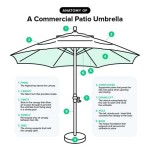The Enduring Benefits of Installing Tile for Patios
The selection of appropriate materials for outdoor patios necessitates a careful consideration of factors encompassing durability, aesthetics, maintenance, and cost-effectiveness. Among the various options available, tile emerges as a compelling choice due to its inherent advantages and versatile application. The decision to install tile for patio surfaces offers a multitude of long-term benefits, enhancing both the functionality and aesthetic appeal of outdoor living spaces. This article will explore the key advantages of utilizing tile for patio construction, providing a comprehensive understanding of its suitability for diverse climates and design preferences.
Enhanced Durability and Longevity
One of the primary benefits of opting for tile in patio construction lies in its inherent durability. Unlike materials such as wood or concrete, tile exhibits exceptional resistance to weathering, fluctuating temperatures, and physical wear and tear. The inherent properties of tile, particularly porcelain and certain types of ceramic, contribute to its ability to withstand the elements without significant degradation. Exposure to rain, snow, and intense sunlight does not typically cause warping, cracking, or fading in properly installed tile. This resistance translates to a longer lifespan compared to other patio materials, reducing the need for frequent repairs or replacements and ultimately providing a more cost-effective solution over time.
The durability of tile is further enhanced by its imperviousness to common patio stressors. Unlike porous materials, tile does not readily absorb water, preventing the freeze-thaw cycle from causing cracks and structural damage in colder climates. This resistance to water absorption also minimizes the risk of mold and mildew growth, contributing to a healthier and more sanitary outdoor environment. Furthermore, tile exhibits significant resistance to staining from spills, dirt, and other environmental factors. This ease of cleaning and maintenance contributes to its long-term aesthetic appeal and reduces the overall upkeep required to maintain a pristine patio surface.
The selection of specific tile types directly influences the overall durability of the patio. Porcelain tile, for instance, is renowned for its exceptional strength, density, and resistance to moisture absorption. Its high firing temperatures during manufacturing result in a hardened material capable of withstanding heavy foot traffic and extreme weather conditions. Ceramic tile, while generally less dense than porcelain, still offers excellent durability for patio applications, particularly when selected with appropriate ratings for outdoor use. The specific PEI (Porcelain Enamel Institute) rating, which measures a tile's resistance to abrasion, should be carefully considered to ensure the chosen tile is suitable for the anticipated level of foot traffic and use.
Proper installation techniques are also crucial for maximizing the durability of tile patios. A solid and level substrate is essential to prevent cracking and shifting over time. The use of appropriate adhesives and grouts, specifically designed for outdoor applications, ensures a strong and watertight bond between the tiles and the underlying surface. Furthermore, allowing for expansion joints during installation accommodates the natural expansion and contraction of materials due to temperature fluctuations, preventing stress cracks and maintaining the structural integrity of the patio surface.
Aesthetic Versatility and Design Flexibility
Beyond its functional advantages, tile offers unparalleled aesthetic versatility and design flexibility, allowing homeowners to create customized and visually appealing outdoor living spaces. Tile is available in a vast array of colors, patterns, sizes, and textures, providing virtually limitless design possibilities. From classic and traditional styles to modern and contemporary aesthetics, tile can be seamlessly integrated into any architectural landscape. This adaptability makes tile an ideal choice for homeowners seeking to personalize their patios and create a unique outdoor ambiance.
The wide range of available colors allows for the creation of patios that complement the surrounding landscaping and architecture. Neutral tones, such as grays, beiges, and browns, can create a sophisticated and understated look, while bolder colors can add vibrancy and personality. Patterned tiles, including geometric designs, mosaics, and intricate motifs, can be used to create focal points or to define specific areas within the patio space. The ability to mix and match different tile colors and patterns allows for further customization and the creation of truly unique designs.
Tile's versatility extends to its ability to mimic the appearance of other natural materials. Wood-look tiles, for example, offer the aesthetic appeal of hardwood decking without the associated maintenance requirements. Stone-look tiles can replicate the texture and appearance of natural stone, such as slate, travertine, or granite, providing a sophisticated and durable alternative. These imitation tiles offer the best of both worlds: the aesthetic appeal of natural materials with the durability and ease of maintenance of tile.
The modular nature of tile allows for creative installation patterns and layouts. Running bond patterns, herringbone patterns, and basketweave patterns are just a few examples of the various layout options available. These patterns can add visual interest and dimension to the patio surface, enhancing its overall aesthetic appeal. Furthermore, the use of different tile sizes and shapes can create unique and visually striking designs. Large format tiles, for instance, can create a seamless and modern look, while smaller mosaic tiles can be used to create intricate borders or accent features.
Ease of Maintenance and Cleaning
Another significant advantage of tile for patios is its ease of maintenance and cleaning. Unlike materials that require regular sealing, staining, or painting, tile typically requires minimal upkeep to maintain its pristine appearance. Its non-porous surface resists staining, dirt, and grime, making it easy to clean with simple household cleaning products. This low-maintenance nature makes tile an ideal choice for homeowners seeking a hassle-free patio surface.
Regular cleaning of tile patios typically involves sweeping or vacuuming to remove loose debris, followed by washing with a mild detergent and water. Stubborn stains can usually be removed with a specialized tile cleaner or a mixture of baking soda and water. The use of harsh chemicals or abrasive cleaners should be avoided, as they can damage the tile's surface or grout lines. With proper care, tile patios can maintain their original beauty for many years.
The grout lines between tiles are often the most susceptible to staining and discoloration. To prevent this, it is recommended to seal the grout lines after installation and to re-seal them periodically. Grout sealers create a protective barrier that repels water and stains, making it easier to clean and maintain the grout's original color. Furthermore, the use of epoxy grout offers enhanced stain resistance and durability compared to traditional cementitious grout.
In addition to regular cleaning, occasional maintenance may be required to address minor issues such as cracked or chipped tiles. Replacing damaged tiles is a relatively straightforward process, and replacement tiles can often be obtained from the original supplier or a local tile store. Promptly addressing any damage prevents further deterioration and maintains the overall integrity and appearance of the patio surface.
The minimal maintenance requirements of tile patios translate to significant time and cost savings over the long term. Homeowners can spend less time on upkeep and more time enjoying their outdoor living spaces. This ease of maintenance, combined with the other benefits of tile, makes it a highly desirable and practical choice for patio construction.
In conclusion, the decision to install tile for patios offers a compelling combination of durability, aesthetic versatility, and ease of maintenance. Its ability to withstand harsh weather conditions, resist staining, and offer virtually limitless design possibilities makes it a superior choice compared to many other patio materials. By carefully selecting the appropriate tile type, employing proper installation techniques, and following recommended maintenance practices, homeowners can create beautiful and functional outdoor living spaces that will provide enjoyment for years to come.

Transform Your Patio With Outdoor Tile Ideas And Inspiration

Benefits Of Tile Flooring Installers Miami Pros

Porcelain Paver Backyard A Guide For Outdoor Tiles Stone Tile Depot

The Benefits Of Concrete Pavers Over Patio Tiles Belgard

Using Porcelain And Ceramic Tile In Outdoor Kitchens Why

Outdoor Tile Installation Tools And Best Practices Rubi Blog Usa

The Benefits Of Using Rock Tite To Install Porcelain Paving Slabs Walls And Floors

The Benefits Of Concrete Pavers Over Patio Tiles Belgard

Laying Porcelain Tiles Outside Tools And Best Practices

Outdoor Flooring Discover The Benefits Of Having Tiles Outside
Related Posts








